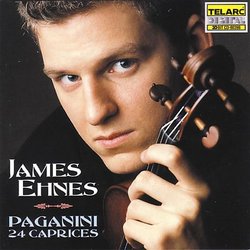| All Artists: Niccolo Paganini Title: Niccolo Paganini: 24 Caprices For Solo Violin Members Wishing: 1 Total Copies: 0 Label: Telarc Release Date: 6/24/2003 Genre: Classical Styles: Chamber Music, Historical Periods, Classical (c.1770-1830), Instruments, Strings Number of Discs: 1 SwapaCD Credits: 1 Other Editions: 24 Caprices UPC: 089408039829 |
Search - Niccolo Paganini :: Niccolo Paganini: 24 Caprices For Solo Violin
 | Niccolo Paganini Niccolo Paganini: 24 Caprices For Solo Violin Genre: Classical
|
Larger Image |
CD Details |
CD ReviewsSlightly better than Perlman's. Enaitz Jar | Spain, Europe. | 10/02/2004 (5 out of 5 stars) "After listening to all Paganini's Caprices recordings available, I think that James Ehnes is the perfect Paganini's Caprices player, closely followed by Itzhak Perlman's (It's been real hard to decide between Perlman and Ehnes). Midori is acceptable and delicate but I prefer any Ehnes' or Perlman's work first than Midori's. Accardo's is also acceptable. With Ehnes you can hear any single note with clarity, even the fastest lick sound pure and crystal clear. Also it has great sonority, control, and an awesome musical expressivity. This young (born in 1976) canadian genious may not be a very well known violinist by now, but with recordings like this amazing performance he's gonna become a classical master for sure, if not yet. Also the sound quality is exceptional due to the use of 20 bits cd mastering, in addition to the most advanced recording techniques and the best studio equipment. Think that this was recorded by Telarc in 1995, while other recordings (as for example Perlman's), are much older, generally from the sixties or seventies. Ehnes used on this recording the 1717 Windsor Weinstein Stradivarius violin leaned in 1994 by the Canada Council in recognizement for his amazing playing habilities. A 1742 Guarneri "Del Gesu" violin (Paganini's favourite) should have been obviously the perfect option for this recording, but the Stradivarius used instead sounds so great that we can forget about "Il Canone" without missing it. Kaler's is, in my opinion, some kind mediocre, and Rabin's sound is terrible, with too little sonority, and seems to be too fast, noisy and uncontrolled. This work is a demonstration on how far can the violin technique go. Paganini was the best violin player of his time. He had a pintoresque sparkling personality. Because of his devilish aura and look he was said to have a contract with the devil to make him the best violin player ever. He used to say that the main reason to write his music was to prove that no other violin player could ever play it. In fact, the 24 Caprices are a point of break between the usual violin techniques and the "supernatural" ones. Paganini introduced a blend of new and surprising techniques as the double stop, unusual pizzicato, complex chords, and things like playing a pizzicato on two strings while playing with the bow on the other two strings, or playing the same melody on two different octaves at the same time, always playing close to the speed of light. Listening to this record you can't believe is all played by a single violin player in a single session (sometimes makes me remember those early seventies Brian May's symphonic like guitar solos). He introduced the virtuoso attitude and lifestyle now usual on modern rock'n'roll superstars. The importance of this composition can be noted seeing all the master musician and composers who had been deeply inspired by it. It has been written variations to the Caprices by genious like Lutoslawsky, Brahms, Rachmaninov, Liszt, or, specially, Andrew Lloyd Webber, with an amazing set of variations for cello and rock band (featuring Gary Moore, Rod Argent, Phil Collins, ...) directly inspired by the 24th Caprice. Ehnes recording is for sure the best chance to hear the absolutely wonderous Caprices the way Paganini played it." Very good recording - but not on a par with Ricci Hans U. Widmaier | Elmhurst, IL USA | 11/19/1999 (3 out of 5 stars) "As you would expect, Perlman plays with gorgeous tone, rock-solid technique, (mostly) very good intonation, and pleasing if conventional phrasing. But often he sounds pedestrian, careful, unwilling to max out his technical endowment, diligently keeping within his capabilities. What is missing here is the excitement of someone noticeably pushing themselves to and beyond their own limits, someone taking existential risks as, say, Horowitz and Callas have often done to such great effect. But that is what these pieces are really all about: achieving things that are seemingly physically impossible. Compare, for example, Perlman's Caprice #5 to Ruggiero Ricci's (in his earlier recordings): the difference is staggering. Ricci has the daredevil, take-no-prisoners approach that these pieces call for and that Perlman largely lacks. Beyond that, Ricci plays faster, is more precise, and has a better intonation than Perlman, especially in the most difficult passages." Excellent and crystal clear Enaitz Jar | 10/10/1999 (5 out of 5 stars) "This recording by James Ehnes is remarkable. Although not a very well-known recording artist, he plays these caprices with the technical authority it needs. His tone and execution is explosive and more than anything, his technique is clear and precise. Well done!!!"
|

 Track Listings (24) - Disc #1
Track Listings (24) - Disc #1